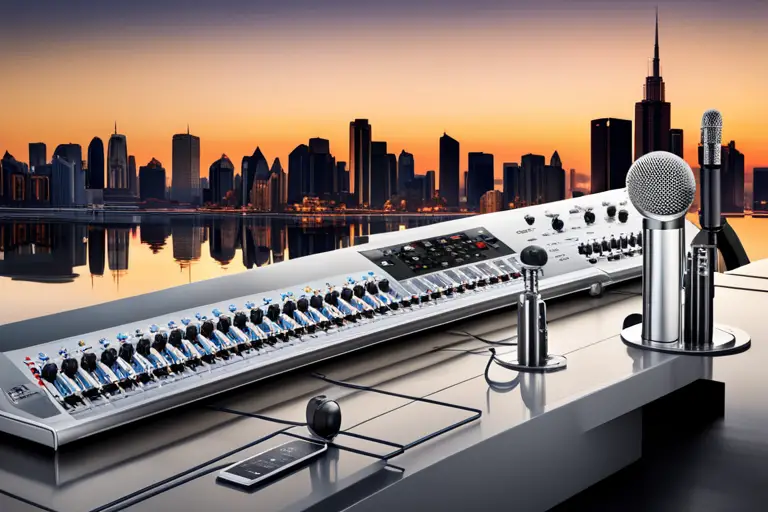Are you a content creator struggling to get your message heard on social media? Have you ever considered the impact of your audio quality on your audience’s engagement? The art of mixing for social media audio content is a crucial skillset for any content creator looking to stand out in today’s crowded online space.
In this article, you will learn:
– The importance of audio quality
– Setting up your audio workspace
– Balancing audio elements
– Optimizing for different devices
– Understanding social media audio standards
– Mastering your mix
– Sharing your audio content on social media platforms
By the end of this article, you will have a better understanding of how to create high-quality audio content that will help you reach and engage your audience on social media.
Understanding the Importance of Audio Quality
If you want your social media content to sound like a professional masterpiece, you’ve gotta prioritize audio quality like it’s the missing puzzle piece.
Social media platforms like Instagram, TikTok, and YouTube thrive on the visual content they offer, but audio quality can make or break a viewer’s experience. It’s the difference between someone scrolling past your video without a second thought or staying engaged and watching until the very end.
Poor audio quality can make your content seem amateurish and unprofessional, which can hurt your brand or personal image. It can also be distracting and annoying for viewers, making it difficult for them to focus on the message you’re trying to convey.
Investing in good quality equipment, such as a microphone or audio interface, can help improve your audio quality. Additionally, taking the time to learn about basic audio editing techniques can help you remove background noise or enhance the sound of your voice.
By prioritizing audio quality in your social media content, you’ll be able to capture and retain viewers’ attention and create a more professional image for yourself or your brand.
Setting Up Your Audio Workspace
Get your workspace ready for recording by organizing your equipment and creating a comfortable environment.
First, make sure you have all the necessary equipment, such as a microphone, headphones, and audio interface, in place. Position your microphone correctly to ensure the best sound quality, and set the gain level accordingly. Check your headphones to make sure they’re working properly and that you can hear yourself clearly.
Next, create a comfortable and quiet environment for recording. Choose a room with good acoustics, and try to reduce any background noise. You can use soundproofing panels or blankets to absorb any unwanted noise.
Make sure your workspace is well-lit and that you have a comfortable chair to sit in. This will help you to stay focused and relaxed during the recording process. By setting up your audio workspace properly, you can ensure that your recordings sound professional and polished, which will help you to engage your audience and build your social media following.
Balancing Audio Elements
To achieve a well-rounded sound, it’s important to balance all the different elements of your recording. This means making sure that none of the audio elements are overpowering the others, and that they are all working together in harmony.
One way to do this is by adjusting the volume levels of each element until they are all at a similar level. You can also use EQ to boost or cut certain frequencies in your audio, which can help to bring out certain elements that may be getting lost in the mix.
Another important aspect of balancing audio elements is making sure that they are panned correctly. This means that each element is placed in a specific location in the stereo field, creating a sense of space and depth in your recording.
For example, you may want to pan your vocals to the center of the mix, while panning your guitar or piano to the left or right. By arranging your audio elements in this way, you can create a more immersive listening experience for your audience, and help to highlight the different elements of your recording.
Optimizing for Different Devices
You want your music to sound great no matter where it’s being played, so it’s important to optimize your recordings for different devices. This means considering how your audio content will be consumed by your audience.
For example, if you’re creating content for Instagram, you’ll want to make sure that your audio is optimized for mobile devices, which typically have smaller speakers than computers or other devices. This can involve adjusting the EQ of your recordings to ensure that they sound good on smaller speakers.
Another factor to consider when optimizing your audio for different devices is the format in which you’re delivering your content. Different devices support different file types, so it’s important to choose a format that will work well across all devices.
For example, if you’re creating audio content for YouTube, you’ll want to make sure that your recordings are in a format that is compatible with both desktop and mobile devices.
By optimizing your audio for different devices, you can ensure that your content sounds great no matter where it’s being played, which can help you reach a wider audience and grow your social media following.
Understanding Social Media Audio Standards
Understanding the standards for audio on social media can be tricky, but it’s important to know which formats and specifications are required for different platforms in order to ensure that your recordings are optimized for the best possible listening experience.
Each platform has its own unique requirements, such as the maximum file size and length, as well as audio format and bit rate. For example, Instagram requires MP4 or MOV format with a maximum length of 60 seconds and a maximum file size of 15MB, while YouTube supports a wider range of audio formats and allows for longer recordings.
It’s also important to consider the fact that most people listen to social media content on their mobile devices, which can greatly affect the quality of the audio. For this reason, it’s recommended to use a higher bit rate and sample rate to ensure that the audio is clear and not distorted when played through a smartphone or tablet.
Understanding these standards and taking the time to optimize your audio content for each platform can go a long way in ensuring that your audience has the best possible listening experience and can fully engage with your content.
Mastering Your Mix
Achieving a professional sound that captivates the listener is the ultimate goal of any music producer. To master your mix, you need to be mindful of the frequency balance, levels, and stereo image of your audio content.
First, make sure that no frequency range is overwhelming or lacking in your mix. Use equalization to adjust and balance the frequencies of each track until they sound cohesive and clear.
Second, pay attention to the levels of each track, ensuring that they are harmoniously mixed together. Adjusting the volume of each track can help create a dynamic and engaging sound.
Lastly, consider the stereo image of your content. Use panning to create a spacious and immersive sound, and avoid cluttering the center of the mix with too many sounds.
By mastering these techniques, you can ensure that your audio content is of professional quality and stands out on social media platforms.
Sharing Your Audio Content on Social Media Platforms
Now that you’ve mastered your mix, it’s time to share it with the world! Social media platforms are a powerful tool for promoting your audio content and reaching a wider audience. But with so many platforms to choose from, it can be overwhelming to know where to start.
First, consider your target audience and which platforms they are most active on. For example, if you’re creating content for a younger demographic, you may want to focus on TikTok or Instagram. If you’re targeting professionals, LinkedIn may be the way to go.
Once you’ve identified your target audience and platform, optimize your content for that platform. Each platform has its own unique features and requirements, so be sure to tailor your content accordingly. This includes optimizing your audio quality for the platform’s compression and ensuring your content is visually engaging.
With the right approach, social media can be a powerful tool for building your brand and growing your audience.
Frequently Asked Questions
What are some common mistakes to avoid when mixing audio for social media content?
When mixing audio for social media content, avoid common mistakes such as using too much compression or EQ, neglecting to check audio levels, and ignoring the importance of consistency in sound quality across different platforms.
Can you provide tips for creating a consistent sound across different social media platforms?
To create a consistent sound across different social media platforms, use similar EQ settings, compression, and reverb. Pay attention to the volume levels and use the same mastering settings. Test the mix on different devices and platforms to ensure consistency.
How can I improve the audio quality of my recordings without investing in expensive equipment?
To improve audio quality without expensive equipment, try recording in a quiet environment, close to the microphone. Use a pop filter to reduce distortion, and edit the audio for noise reduction and EQ.
What are the best practices for adding background music or sound effects to social media content?
When adding background music or sound effects to social media content, choose tracks that fit the mood and tone of your message. Use audio editing tools to adjust the volume and timing for a polished result.
How can I measure the success of my audio content on social media platforms?
To measure the success of your audio content on social media platforms, track the number of listens, comments, and shares. Analyze engagement rates and adjust your content accordingly to maximize its impact.
Conclusion
Congratulations! You’ve learned the art of mixing for social media audio content. By now, you understand that audio quality is crucial to the success of your content and how to create an optimal audio workspace.
You’ve also learned how to balance audio elements, optimize for different devices, and master your mix. It’s important to remember that understanding social media audio standards is also a key component.
With this knowledge, you can ensure that your content meets the requirements of different platforms and reaches a wider audience. By following these steps and sharing your audio content on social media platforms, you can create engaging and high-quality content that resonates with your audience.
Keep practicing and refining your skills, and you’ll be well on your way to becoming a master of social media audio mixing.

Hey there, tech enthusiasts! I’m your go-to content writer, delving into the fascinating world of technology hacks. Get ready to unlock mind-blowing secrets and discover innovative solutions through my engaging and insightful blogs.


